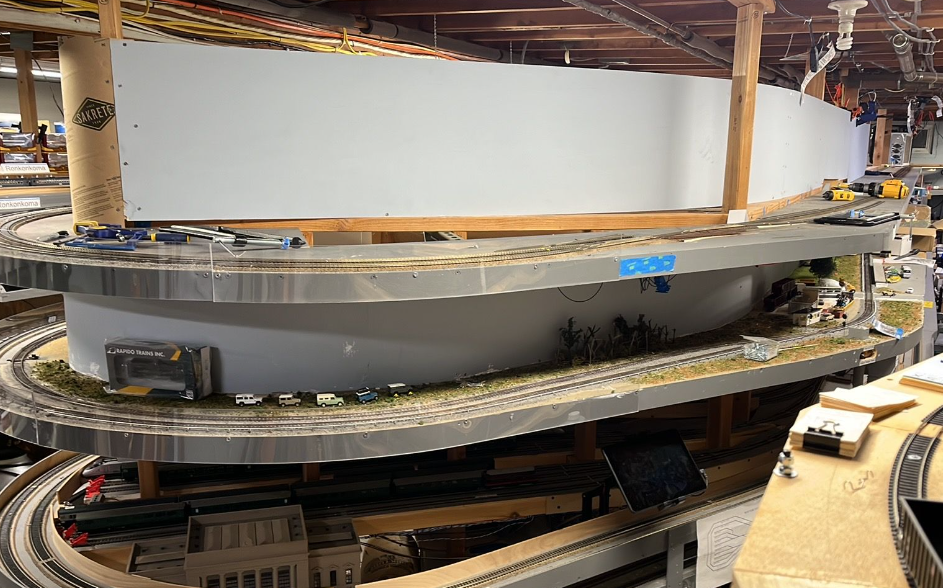“Design Train Length” is a long-standing model railroad design concept. The most common application has to do with siding lengths matching the longest train, and “believable” distance between towns – the caboose of your train should not be in the town behind the town you are entering.
I did have these considerations, but there were some others.
The focus of the railroad is NY&A Freight operations, but LIRR passenger service has a substantial role to play as well. You could say that the LIRR trains are “rolling scenery” for the NYA jobs, but regular passenger trains define the time slots that NYA can work in when they are out on the main line.
So the scenario involves many, many passenger trains, stopping at stations, etc. long story short passenger service is a key feature.
Passenger train length
Prototype LIRR electric service uses trains from between 6 to 12 cars in length. I chose 4×85′ Electric Multiple Units as my design length for passenger trains – or 4 real-scale feet. This also accommodates a diesel hauling 4 cars behind it (the engine doesn’t have to platform). A few “major stations” have somewhat longer platforms, Jamaica has 5′ and 6′ foot platforms as does LI City. One Platform at Hicksville is 4’6″. The idea is that “peak diesel trains” could run with more cars and, prototypically, not all doors would open at every platform. Pinelawn, Medford, Yaphank, Riverhead and Mattituck all have short (2-foot) platforms as in real life.
This compression reduces the infrastructure required to support passenger operations so it has less impact on the overall layout. It makes feasible storing 8 trains inside the return loop that serves as “New York”, and allows for 8 trains stored on 4 tracks at Ronkonkoma.


Platform widths
2-1/8 inches is the width I use for “island platforms” (between two tracks) when the tracks themselves are on 4″ centers. This is a “close enough” compromise which allows for a lot of factors like sloppy track work and over-scaled cars. If a visiting operator is focusing primarily on the gap distance between the platform and the cars, I must imagine that I’m not creating a very challenging operating scenario for them…
Signal Block lengths
The placement of signals at interlockings is fairly non-negotiable. Once those were placed, my approach was to keep the block lengths as uniform as possible, and to have at least one signal between every station pair as station stops are where trains tend to bunch up. Uniform block lengths give smoother operation for trains with similar performance characteristics. Rather organically I wound up with an average signal block length of 16′ which is about 1/3rd of a mile in HO scale.
Freight train and track lengths
*NO* consideration was given to freight train length or speeds when developing the signal system, as they are the exception on this railroad. For the most part freight train lengths are dictated by the amount of work that the job can do during its run, with all constraints in mind.
Within freight sidings and yards, I did consider lengths to an extent. for example I made sure that two geeps could pull two tracks at Coastal and fit between the coastal switch and the end of the siding.

The body of Pine Aire Yard, from west ladder switch to east ladder switch is equal to the amount of available siding length on either side that is used as the switching lead.

Yaphank
Siding lengths on the East End single track main are critical for freight crews , since they must be able to run around their cars when it’s time to head back west. Yaphank was too short – and this was because I had made an aesthetic choice about not extending the siding around the turn back blob. When Brookhaven Rail Terminal began to take cuts of cars, 12-15 at a time, it was gently pointed out to me by a couple of professional railroaders that is was “F@#%** impossible to run the job” with the siding 18 cars long as it was built, and the train carrying in excess of 25 cars…

The siding was extended around the corner and now takes 36 cars. Nicolia concrete had to be moved as a result and the cement unloading track was removed in the process. Nicolia (aka Arriva) only takes stone loads anyway and with Sills Road (Brookhaven Rail) open the cement cars should be going there anyway. MOW has not yet removed the old turnout!

Food for thought.
In the mean time: Backdrops for the top deck are in progress
